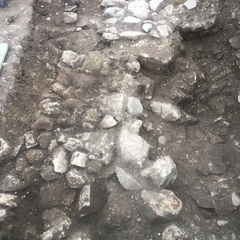Basic Information
- Earlier structure underlying pebbled courtyard (1011)
Contexts
-
Context: MDC_1021
Narrative
-
- The earliest phase of activity and construction was represented by wall foundations F10 which were exposed in plan in the northwest corner of the trench during the last few days of excavation and only partially excavated due to time constraints. The wall foundations were unbounded and made of roughly faced limestone blocks (1021) and would have been for a NNW-SSW aligned wall. The full extent of the foundations were unclear, continuing northeast beyond the limit of excavation and southwest beneath later structural remains, and due to the lack of further excavation it was not possible to attribute any function or usage to wall foundations F10. The wall foundations may have been for an isolated feature demarcating a boundary or have been part of a sequence of walls associated with a building. The only notable feature of wall foundations F10 was that they were on a NNW-SSW alignment and a different alignment from subsequent E-W aligned walls F15 and F16 and N-S aligned wall F17. The change in alignment of the walls is noteworthy and appears to suggest an earlier phase of building predating and potentially not related to the Bishop’s Palace.
-
- Indie Jago
- 16-10-2020
-
- The foundation of an earlier building was located beneath the pebbled courtyard to the north of the structure defined by walls (1002), (1003) and the curtain wall (1008). The orientation of this building was north-north-east to south-south-west, as opposed to other later structures within the enclosure which appeared to generally conform to north–south and east–west alignments. The earlier building was constructed on top of the buried clay soil horizon (1018) which overlay the bedrock geology (1015) and was immediately overlain by the pebbled courtyard surface (1011). A single course of the masonry foundation remained extant, which had been truncated at its south-east corner by foundation cut (1025) for wall (1002). The purpose of this building remains unknown.
-
- Chris Scott
- 28-8-2019
Dating Narrative
-
- No dating evidence was recovered from wall foundations, although a terminus post quem is provided by the subsequent structural remains and associated occupational horizons of AD 1150-1300.
-
- Indie Jago
- 16-10-2020
